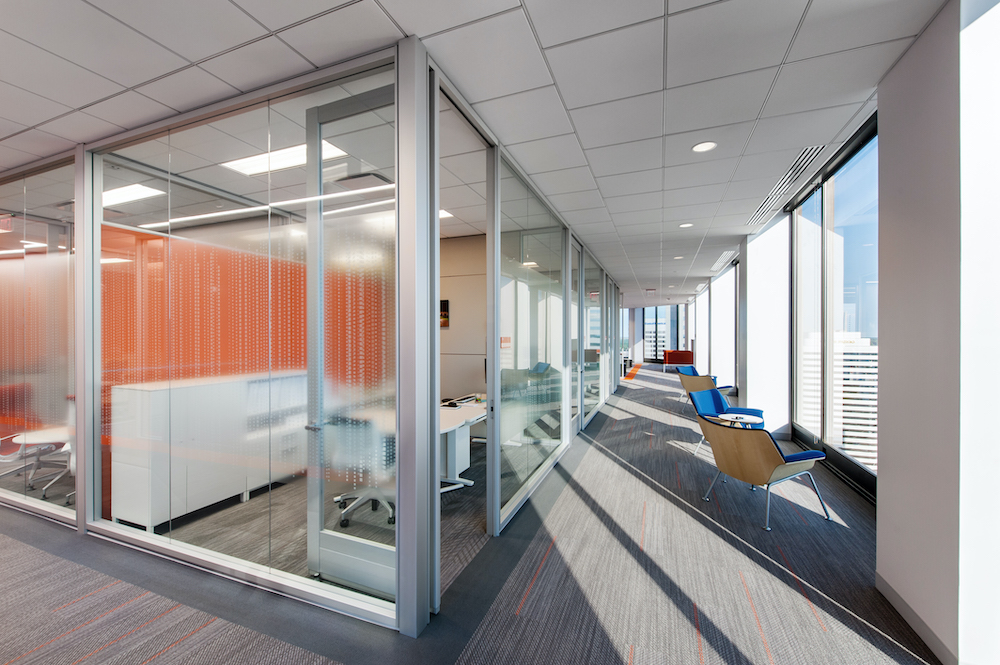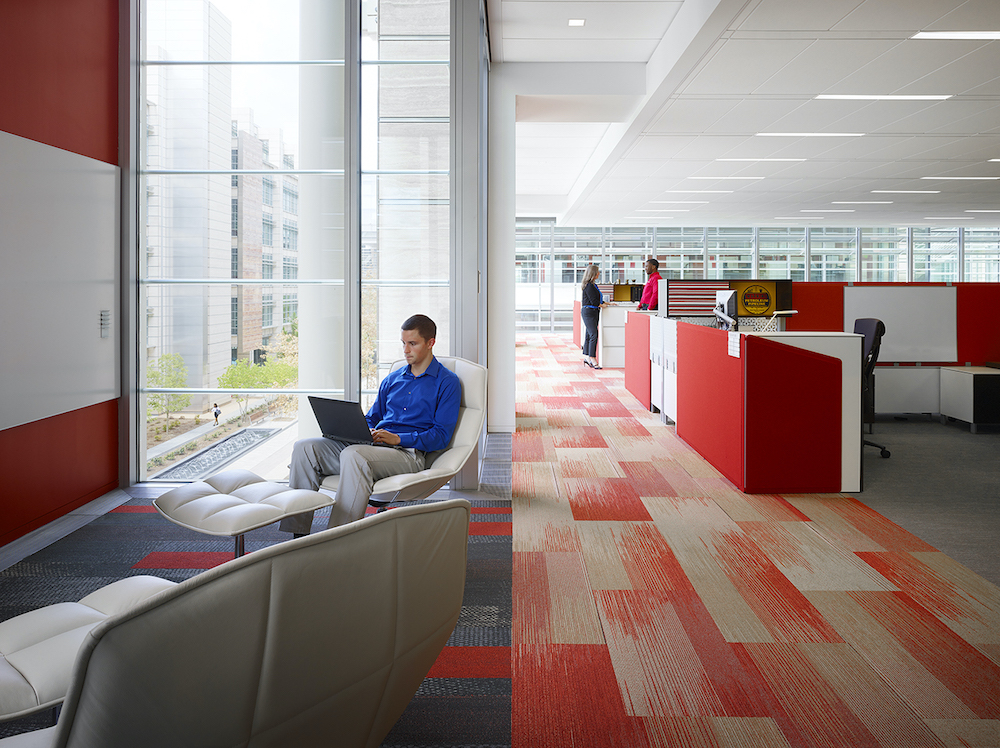PDR’s Larry Lander shares an in-depth guide to creating designs and policies that positively impact employee physical and mental health.

We’re approaching an anniversary few could have imagined: The two-year anniversary of the pandemic. Since then, there has been a fundamental shift in attitude about what offices need to be, why we have them at all, and, for many organizations, a deep dive into precisely what work means.
We’ve learned some important lessons over the past two years—particularly how a workplace can be a healthful place that promotes real employee wellness. It has cast a spotlight on both design and policy decisions that can harm employee health and wellbeing. A thoughtful analysis reveals that many of these “new ideas” were good ideas even before the pandemic, and maybe our most significant learning is that we might be wise to embrace some of them and amplify them.
Successful organizations put their people first because they are the most valuable resource of every business. This article breaks down 12 strategies around employee health and well-being that should be addressed in all organizations large and small. While solutions will vary, there are significant commonalities that fall into two broad categories:
- Workplace Design: the physical arrangement of spaces and how they are used;
- Workplace Policy: our codifying of attitudes and behaviors we want in our organization.

Workplace Design
Quiet Please!
The decades-long debate about open office vs. closed offices often misses the mark with our collective experiences of poorly executed examples of both. Who hasn’t experienced that office space next to the guy with the speakerphone? (Really, does every call need to be on a speakerphone?)
The most effective workplaces offer a strategy around acoustics and privacy for all the spaces. Collaborative spaces can be open and compelling while controlling noise and creating a sense of privacy without actual walls. Private spaces can be truly private with walls, ceilings, doors, and glass that keep the outside out and the inside in. An effective workplace needs both private and collaborative spaces to send employees home happier at the end of the day.
It’s Airborne!
The science of pathogen spread is real, but that’s not a new concept. Rather, the last two years have been a reminder of how important this idea is, and has shed a new light on how we heat and cool workplaces. Tenants and real estate brokers have become much more comfortable talking about technical aspects of fresh air, air movement, and mechanical systems. Year-over-year, the number one issue for facility staff is hot and cold calls. Overlay that with a global pandemic, and our newfound interest in how buildings work mechanically is welcome.
Wow, This Is Grand!
Back in the day, we didn’t call it social distancing. But for a long time, we’ve known the single biggest factor to impact the quality level of a project is what we mysteriously call the Circulation Factor—how much of the space is dedicated to where people walk. The notion that less circulation somehow creates better space is under attack as designers institutionalize the need to bring people together, but not too together! Hallways and corridors can allow two people to walk side-by-side, pass comfortably and safely, or even provide places to work. A new healthy model for a workplace prioritizes the corridors as part of a great place to be. A healthy workplace can feel both grand and safe.
Change It!
In a time where so much seems out of control, organizations can do a better job of restoring individuals’ control during the workday. One moment, quiet focus work, and the next, working intently on a team project. A break for coffee, a funny video, a catch-up with a friend, then a quick pivot to a Zoom call with colleagues around the globe. We all know these days, and while the pandemic has amplified them, these activities are not new. An employee’s sense of control and calm in the storm of a typical day directly connects to one’s mental health. So, building systems that can provide flexibility and control can be the foundation for a healthy workplace. Individual control for heat and cooling, furniture that is easy to move and reconfigure, spaces that can quickly transform from open to closed, and intuitive connectivity to technology create a truly flexible and ultimately controllable environment. A flexible workplace is a healthy workplace.
A Walk in the Park
We all know first-hand the tangible and measurable healing effects of nature. Effective workplaces are embracing this aspect in real ways. Circulation paths on the floor’s perimeter give the view to all—whether on the ground floor looking out to a park or on the hundredth floor with views forever. Sunlight and a connection to the outdoors are linked to each seat and workspace. Balconies, outdoor plazas and decks, rooftops, and gardens are now augmented work environments fully capable of supporting meetings, providing a comfortable place to work, and ensuring connectivity to the rest of the organization.
What’s the Buzz?
First and foremost, the workplace must entice people to be there, particularly with the competition from increasingly effective home offices. One’s colleagues and actual day-to-day tasks are a big part of this equation. Still, the design of a workplace that offers more amenities, more technology, and more flexibility than staying at home will be a workplace that draws workers to it. This outfitted office sets a tone for a positive employee experience. It lays the foundation for engaged workers—exactly the kind of workforce that enables an organization to thrive and succeed. The workplace must be a compelling place to be.

Workplace Policy
In Control
The most successful organizations are experimenting with hybrid policies that revolve around individual choice about where and when to work. Employees’ mental health is just as important as physical health, and employees’ ability to choose their work setting has an outsized impact on satisfaction. An organization’s flexible work policies, introspection on the role of presenteeism, and some adjustment of traditional norms and protocols will truly create a hybrid work environment that advances the organization, achieves business goals, and satisfies individual employee needs.
Collegiality
The notion that each individual is somehow part of something bigger is the foundation of the most successful organizations. We call that collegiality. Maybe your alma mater won the championship when you were there, or maybe somebody won a Nobel Prize. You likely weren’t on the football team or even worked with the prize winner, but you were there. You were part of something important, and you’re proud of it still. Companies are embracing their own spirit, a mission, or promoting a culture that at a fundamental level provides a glue or connection for employees and future employees. This attacks the very epidemic of loneliness the pandemic has spawned.
A Better Kitchen Table
When did you get the extra monitor, the better webcam, the more effective lighting? As the pandemic has dragged on, what started as an experiment to work from home has morphed into a normal part of life. But the hybrid work arrangement—some days in the office, some days from home, doesn’t really work unless the home component can match the office capability. As the effectiveness of working from home has become apparent and the gains for employees’ mental and physical health, organizations are increasingly investing in the physical setup for employees’ homes. With a real spot, sophisticated tools, and better connectivity – we can work anywhere.
We’re All Remote
The hybrid workplace has upended our notion of remote work, expectations, and protocols around how meetings and collaboration can work. The old model—one person “calling in” and relegated to a disembodied voice on the speakerphone in the middle of the table, has been replaced by the reality that we’re not all together in the room, and everyone has an equal chance to see and be seen, to hear and be heard. Rapid improvements to technology, evolving protocols around how to share the figurative tabletop, and expectations around behaviors have given confidence to individuals. No matter where they are, they feel like an essential part of the meeting, their voice is valued, and they will be heard.
Free, Tentative, Busy, Away
The evolution of a protocol that amplifies the flexibility of this new hybrid work environment starts with managing our collective calendar. Presenteeism—the notion that the only way to be effective is to be in person has been cast aside as flexible schedules evolve. An effective way to bridge the gap and support more flexibility and freedom for individuals is to develop agreed-upon times and protocols for coming together. This can take the form of core hours—a portion of a day or week when there is an expectation that one will be available for work activities. Another option is modifications to the workweek—everyone will be in on certain days, but not every day. Or even more radically, moving from a five-day workweek to a four-day. These give some modicum of control as to when and where work will happen back to employees, strengthening the idea of individual flexibility and a sense that employers care about employees’ mental health and wellbeing. A greater shared focus amplifies engagement and effective work.
I’m Not in the Office Today
Policies around paid time-off have garnered a deeper analysis, with the notion of sick leave coming under the greatest scrutiny. A model of limited sick leave has not kept pace with how the pandemic has affected individuals and families. The very contagious nature of COVID requires quarantines for even individuals who may not exhibit outward symptoms. The behavior showing up to work with a cold is no longer acceptable, and the slightest cough or sneeze from a co-worker has everyone on edge. Companies are increasingly encouraging employees to work from home at the least sign of illness. By embracing hybrid work and remote protocols, employees—whether in person or on a Zoom call—can be healthier.
Wouldn’t it be great if this project left employees healthier when they go home at night than when they arrived in the morning? Sure, we could provide a gym and serve healthier cheeseburgers (we probably ought to do that!), but we might also consider some foundational steps.

